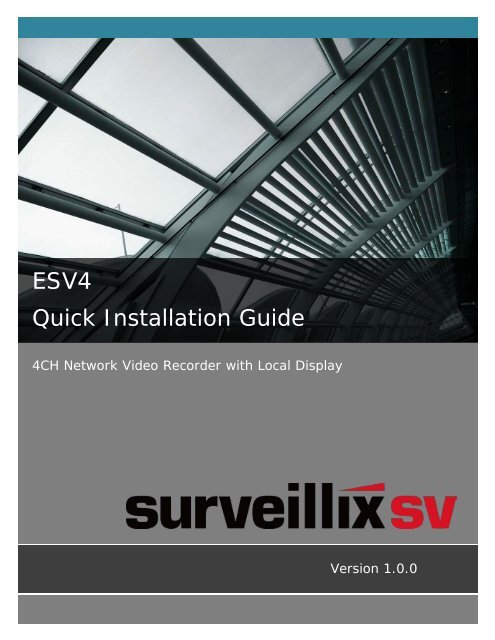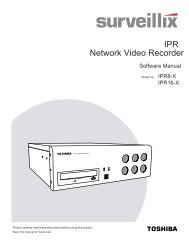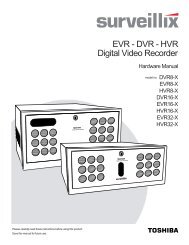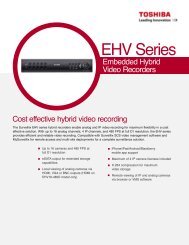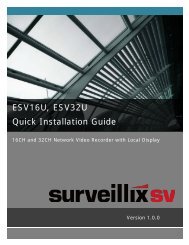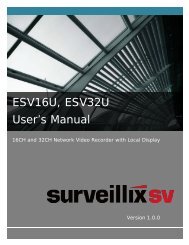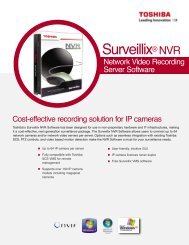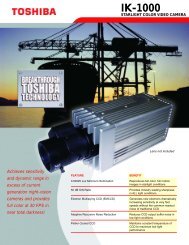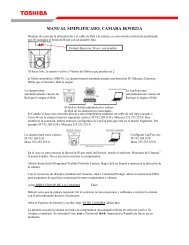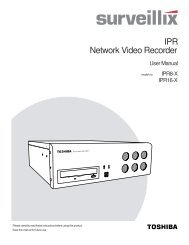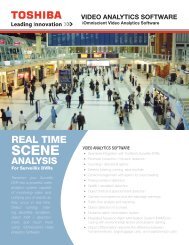Quick Start Guide - Toshiba
Quick Start Guide - Toshiba
Quick Start Guide - Toshiba
Create successful ePaper yourself
Turn your PDF publications into a flip-book with our unique Google optimized e-Paper software.
ESV4<br />
<strong>Quick</strong> Installation <strong>Guide</strong><br />
4CH Network Video Recorder with Local Display<br />
Version 1.0.0
2 ESV4 <strong>Quick</strong> Installation <strong>Guide</strong><br />
Table of Contents<br />
Preliminary ............................................................................... 3<br />
System Overview ...................................................................... 8<br />
Front View ..................................................................................... 8<br />
Rear View ...................................................................................... 9<br />
Part names ................................................................................... 10<br />
LED Definition ............................................................................... 10<br />
Installation ............................................................................. 11<br />
HDD Installation ........................................................................... 11<br />
Connecting to the NVR.................................................................. 16<br />
Using NVR Device Search Utility ...................................................... 16<br />
Access the NVR with its default IP address ........................................ 19<br />
Password Setup ............................................................................ 21<br />
Camera Installation ...................................................................... 22<br />
Adding a Camera -- Automatic Search ............................................. 22<br />
Adding a camera manually ............................................................. 24<br />
Refer to the user's manual (PDF file) contained in the CD-ROM for settings,<br />
operations and other information.<br />
The application Adobe ® Reader ® is needed to view PDF files. If you do not<br />
have this application, download it from the Adobe Systems Incorporated<br />
website.<br />
http://www.adobe.com/<br />
For information on our latest products and peripheral devices, refer to the<br />
following Website:<br />
http://www.toshibasecurity.com
ESV4 <strong>Quick</strong> Installation <strong>Guide</strong> 3<br />
Preliminary<br />
Thank you for purchasing the ESV4 Network Video Recorder (NVR). Before<br />
using the NVR, read this quick installation guide (QIG) carefully to ensure<br />
correct usage. After reading this quick installation guide (QIG), save it for<br />
future reference.<br />
The design, specifications, software, and QIG contents are subject to change<br />
without prior notice.<br />
FCC (USA)-INFORMATION<br />
NOTE: This equipment has been tested and found to comply with the limits<br />
for a Class A digital device, pursuant to Part 15 of the FCC Rules.<br />
These limits are designed to provide reasonable protection against harmful<br />
interference when the equipment is operated in a commercial environment.<br />
This equipment generates, uses, and can radiate radio frequency energy and,<br />
if not installed and used in accordance with the instruction manual, may<br />
cause harmful interference to radio communications. Operation of this<br />
equipment in a residential area is likely to cause harmful interference in<br />
which case the user will be required to correct the interference at his own<br />
expense.<br />
USER-INSTALLER CAUTION: Your authority to operate this FCC verified<br />
equipment could be voided if you make changes or modifications not<br />
expressly approved by the party.<br />
Terms and Trademarks<br />
* The term "OS" is used in this manual to indicate operating systems<br />
compatible with this product.<br />
-- Microsoft ® Windows ® XP xxxx Edition<br />
-- Microsoft ® Windows Vista ® Business Edition<br />
-- Microsoft ® Windows ® 7 Professional Edition<br />
• Microsoft, Windows, Windows Vista and Internet Explorer are trademarks<br />
or registered trademarks of Microsoft Corporation in the United States and<br />
other countries.<br />
• Intel and Intel Core are trademarks or registered trademarks of<br />
Intel Corporation or its subsidiaries in the United States and other<br />
countries.<br />
• Adobe and Reader are either registered trademarks or trademarks of<br />
Adobe Systems Incorporated in the United States and/or other countries.<br />
• Other product names appearing in this quick start guide may be<br />
trademarks or registered trademarks of their respective holders.
4 ESV4 <strong>Quick</strong> Installation <strong>Guide</strong><br />
Important Safeguards<br />
1. Read Instructions<br />
Read all the safety and operating instructions before operating the product.<br />
2. Retain Instructions<br />
Retain the safety instructions and user's manual for future reference.<br />
3. Warnings<br />
Comply with all warnings on the product and in the user's manual.<br />
4. Follow Instructions<br />
Follow all operating and use instructions.<br />
5. Cleaning<br />
Disconnect this NVR from the power supply before cleaning.<br />
6. Attachments<br />
Do not use attachments not recommended by the NVR manufacturer as they<br />
may pose safety risks.<br />
7. Water and Moisture<br />
Do not use this NVR near water. Some examples are: near a bath tub, wash<br />
bowl, kitchen sink, or laundry tub, in a wet basement, or near a swimming<br />
pool.<br />
8. Accessories<br />
Do not place this NVR on an unstable cart, stand, tripod, bracket or table.<br />
The NVR may fall, causing serious injury to a person, or serious damage to<br />
the product. Use only rack with bracket, or table recommended by the<br />
manufacturer, or sold with the NVR. Any mounting of the product should<br />
follow the manufacturer's instructions, and should use a mounting accessory<br />
recommended by the manufacturer.<br />
9. Ventilation<br />
This NVR should never be placed near or over a radiator or heat register. If<br />
this product is placed in a built-in installation, verify that there is proper<br />
ventilation so that the NVR temperature operates within the recommended<br />
temperature range.<br />
10. Power Sources<br />
This NVR should be operated only from the type of power source indicated on<br />
the information label. If you are not sure of the type of power supply at your<br />
location, consult your product dealer.<br />
11. Power-Cord Protection<br />
Power cords should be routed so that they are not likely to be walked on or<br />
pinched by items placed upon or against them. Pay particular attention to<br />
cords at plugs, screws and the point where they exit the product.<br />
12. Installation<br />
Install this NVR on a secure location. If installed on an unsecured location,<br />
the NVR could fall causing injury and damage.<br />
13. Lightning<br />
For additional protection on this NVR during a lightning storm, or when it is<br />
left unattended and unused for long periods of time, unplug it from the wall<br />
outlet and disconnect the power supply and cable system. This will prevent<br />
damage to the NVR due to lightning and power-line surges. If lightning<br />
occurs, do not touch the unit or any connected cables in order to avoid<br />
electric shock.
ESV4 <strong>Quick</strong> Installation <strong>Guide</strong> 5<br />
14. Overloading<br />
Do not overload the power supply or extension cords as this can result in a<br />
risk of fire or electric shock.<br />
15. Object and Liquid Entry<br />
Never push objects of any kind into this NVR through openings as they may<br />
touch dangerous electrical points or short-out parts that could result in a fire<br />
or electrical shock. Never intentionally spill liquid of any kind on the NVR.<br />
16. Servicing<br />
Do not attempt to service this NVR yourself as opening or removing covers<br />
may expose you to dangerous electrical or other hazards. Refer all servicing<br />
to qualified service personnel.<br />
17. Damage Requiring Service<br />
Disconnect this NVR from the power supply and refer servicing to qualified<br />
service personnel under the following conditions.<br />
a. When the power-supply cord or plug is damaged.<br />
b. If liquid has been spilled, or objects have fallen into the NVR.<br />
c. If the NVR has been submerged in water.<br />
d. If the NVR does not operate normally by following the operating<br />
instructions in the user's manual. Adjust only those controls that are<br />
covered by the user's manual as an improper adjustment of other controls<br />
may result in damage and will often require extensive work by a qualified<br />
technician to restore the NVR to its normal operation.<br />
e. If the NVR has been dropped or the cabinet has been damaged.<br />
f. When the NVR exhibiting a distinct change in performance which indicates<br />
a need for service.<br />
g. Other trouble.<br />
18. Other trouble. Replacement Parts<br />
When replacing parts, be sure the service technician uses parts specified by<br />
the manufacturer or have the same characteristics as the original part.<br />
Unauthorized substitutions may result in fire, electric shock or other hazards.<br />
19. Safety Check<br />
Upon completion of any service or repairs to this NVR, ask the service<br />
technician to perform safety checks to determine that the NVR is in proper<br />
operating condition.
6 ESV4 <strong>Quick</strong> Installation <strong>Guide</strong><br />
CAUTION TO REDUCE THE RISK OF ELECTRIC SHOCK.<br />
DO NOT REMOVE COVER. NO USER SERVICEABLE PARTS INSIDE. REFER<br />
SERVICING TO QUALIFIED SERVICE PERSONNEL.<br />
The lightning flash with arrowhead symbol, within an equilateral<br />
triangle, is intended to alert the user to the presence of uninsulated<br />
"dangerous voltage" within the product's enclosure that may be of<br />
sufficient magnitude to constitute a risk of electric shock to persons.<br />
The exclamation point within an equilateral triangle is intended to<br />
alert the user to the presence of important operating and<br />
maintenance(servicing) instructions in the literature accompanying<br />
the appliance.<br />
WARNING:<br />
TO REDUCE THE RISK OF FIRE OR ELECTRIC SHOCK, DO NOT EXPOSE THIS<br />
APPLIANCE TO RAIN OR MOISTURE.<br />
FIELD INSTALLATION MARKING:<br />
WORDED: “THIS INSTALLATION SHOULD BE MADE BY A QUALIFIED SERVICE<br />
PERSON AND SHOULD CONFORM TO ALL LOCAL CODES.”<br />
Precautions for Use<br />
Disclaimer<br />
We disclaim any responsibility and shall be held harmless for any damages or<br />
losses incurred by the user in any of the following cases:<br />
1. Fire, earthquake or any other act of God; acts by third parties; misuse by<br />
the user, whether intentional or accidental; use under extreme operating<br />
conditions.<br />
2. Malfunction or non-function resulting in indirect, additional or<br />
consequential damages, including but not limited to loss of expected income<br />
and suspension of business activities.<br />
3. Incorrect use not in compliance with instructions in this user's manual.<br />
4. Malfunctions resulting from misconnection to other equipment.<br />
5. Repairs or modifications made by the user or caused to be made by the<br />
user and carried out by an unauthorized third party.<br />
Notwithstanding the foregoing, <strong>Toshiba</strong>'s liabilities shall not, in any<br />
circumstances, exceed the purchase price of the product.<br />
Copyright and Right of Portrait<br />
There may be a conflict with the Copyright Law and other laws when a<br />
customer uses, displays, distributes, or exhibits an image picked up by the<br />
camera without permission from the copyright holder. Please also note that<br />
transfer of an image or file covered by copyright is restricted to use within<br />
the scope permitted by the Copyright Law.
ESV4 <strong>Quick</strong> Installation <strong>Guide</strong> 7<br />
Protection of Personal Information<br />
Images taken by the camera that reveal the likeness of an individual person<br />
may be considered personal information. To disclose, exhibit or transmit<br />
those images over the internet or otherwise, consent of the person may be<br />
required.<br />
Usage Limitation<br />
The product is not designed for any "critical applications." "Critical<br />
applications" means life support systems, exhaust or smoke extraction<br />
applications, medical applications, commercial aviation, mass transit<br />
applications, military applications, homeland security applications, nuclear<br />
facilities or systems or any other applications where product failure could<br />
lead to injury to persons or loss of life or catastrophic property damage.<br />
Accordingly, <strong>Toshiba</strong> disclaims any and all liability arising out of the use of<br />
the product in any critical applications.<br />
System Requirements<br />
Recommended personal computer system requirements:<br />
-- Windows ® XP, Windows Vista ® Business, or Windows ® 7 professional.<br />
-- Internet Explorer ® Ver 8.0 or above<br />
-- CPU: Intel ® Core TM 2 Duo 2.4GHz or higher<br />
-- Memory: 2GB RAM<br />
-- Network: 100 Megabit Network Interface or above<br />
-- Graphic adapter: AGP or PCI-Express, minimum 1024x768, 16 bit colors.<br />
Make sure your display DPI setting is set to default at 96DPI<br />
Package Contents<br />
• Network Video Recorder with HDD (ESV4-1T: 1TB HDD installed)<br />
• Power cord<br />
• AC adapter<br />
• LAN cable<br />
• <strong>Quick</strong> Installation <strong>Guide</strong><br />
• Warranty Card<br />
• CD-ROM (User’s Manual, QIG, CMS Basic, NVR Device Search)<br />
• Screws<br />
Pan head #6-32 x 5, 8pcs
8 ESV4 <strong>Quick</strong> Installation <strong>Guide</strong><br />
System Overview<br />
Front View
Rear View<br />
ESV4 <strong>Quick</strong> Installation <strong>Guide</strong> 9
10 ESV4 <strong>Quick</strong> Installation <strong>Guide</strong><br />
Part names<br />
LED Definition
ESV4 <strong>Quick</strong> Installation <strong>Guide</strong> 11<br />
Installation<br />
HDD Installation<br />
Locate the screws highlighted above on the back of the NVR.<br />
Use a Philips screw driver to release the screws.
12 ESV4 <strong>Quick</strong> Installation <strong>Guide</strong><br />
Slide open the case as shown above.<br />
One side of the housing can be detached as shown above.
ESV4 <strong>Quick</strong> Installation <strong>Guide</strong> 13<br />
4 -Ch Network Video<br />
Recorder with HDMI<br />
Install the top HDD by attaching it to the corresponding SATA cable<br />
first.<br />
Make sure the HDD is securely attached.
14 ESV4 <strong>Quick</strong> Installation <strong>Guide</strong><br />
Place the HDD to the tray and make sure the screw holes on the HDD<br />
are aligned with the ones on the tray.<br />
Secure the HDD with the screws provided in the accessory box with a<br />
Philips screw driver. There are four for each HDD; two for each side of<br />
the tray.
ESV4 <strong>Quick</strong> Installation <strong>Guide</strong> 15<br />
Slide the side housing back to the unit.<br />
Secure the housing with the screws highlighted above.<br />
NOTE:<br />
Maximum capacity of each hard disk drive is 3TB.<br />
Do not use hard disk drives with power saving functions such as<br />
Intellipower.<br />
For a list of compatible hard disk drives, visit<br />
www.toshibasecurity.com.”
16 ESV4 <strong>Quick</strong> Installation <strong>Guide</strong><br />
Connecting to the NVR<br />
There are various ways you can connect to the NVR and below are the<br />
suggested methods for different network setup:<br />
Through the browser from another PC on the network:<br />
• The NVR is placed in a network with a DHCP server: Connect to the<br />
NVR by using “NVR Device Search” Utility<br />
• The NVR is placed in a network without DHCP server (or you are<br />
connecting to it directly): Access the NVR with its default IP<br />
Using NVR Device Search Utility<br />
If the NVR is placed in a corporate network or a local area network<br />
where a DHCP server is already presented, run the “NVR Device<br />
Search” utility from a computer that is on the same network and locate<br />
the NVR with its IP address that is assigned by the top-level DHCP<br />
server.
ESV4 <strong>Quick</strong> Installation <strong>Guide</strong> 17<br />
To begin, launch the “NVR Device Search” utility from the CD and<br />
proceed with the installation:
18 ESV4 <strong>Quick</strong> Installation <strong>Guide</strong><br />
Once the installation is complete, check the “Launch the Search AP”<br />
option and click “Finish”.<br />
The search should start automatically and its status should be displayed.<br />
The NVR should be located and its IP address should be displayed.
ESV4 <strong>Quick</strong> Installation <strong>Guide</strong> 19<br />
Double-click on an NVR and the search program should automatically<br />
access the NVR’s web administration page from your default browser.<br />
You will be prompted for the NVR’s username and password. Enter its<br />
default username “admin” and password “admin” and then<br />
click ”OK” to enter the system<br />
Access the NVR with its default IP address<br />
The NVR comes with a pre-configured static IP “192.168.101.50”.<br />
However, it is only used when there is no DHCP server presented in<br />
the network. The NVR will turn on its DHCP server function and act as<br />
the DHCP server in the network. To connect to the NVR, use a PC that
20 ESV4 <strong>Quick</strong> Installation <strong>Guide</strong><br />
is on the same network over a switch or hub, or connect the PC<br />
directly to the NVR using a crossover CAT5 Ethernet cable.<br />
The PC that is connected directly to the NVR (or within the same local<br />
area network) should receive an IP from the NVR. Simply access the<br />
NVR from your web browser with its IP address<br />
Again, you should be prompted for the username and password. Enter<br />
its default username “admin” and password “admin” and then<br />
click”OK” to enter the system
ESV4 <strong>Quick</strong> Installation <strong>Guide</strong> 21<br />
Password Setup<br />
The default login username and password is admin/admin. To change<br />
the password of the admin account, go to “Setup” --> “System Configurations”<br />
--> “User Account”, click on the “admin” account in the<br />
account list then press the “edit” button to change its password.<br />
Finally, click “Apply” to save the change.
22 ESV4 <strong>Quick</strong> Installation <strong>Guide</strong><br />
Camera Installation<br />
Adding a Camera -- Automatic Search<br />
Click the “Search” button to perform the camera search.<br />
You should be prompted to install Active Control component in order<br />
for the search to function properly. Go ahead and click “Install”<br />
After that, the search should begin and its status should be displayed:
ESV4 <strong>Quick</strong> Installation <strong>Guide</strong> 23<br />
Found cameras should be listed and simply select a camera from the<br />
list and press “Configure”<br />
Its corresponding information should be displayed in the “Camera<br />
Information” section. Enter its username and password and select the<br />
channel ID and name the camera.
24 ESV4 <strong>Quick</strong> Installation <strong>Guide</strong><br />
Click on “Detect” to establish connection between the recorder and the<br />
camera. If a connection is established successfully, the camera’s<br />
detailed information will be displayed as below.<br />
Adjust its video format, frame rate, resolution or bitrate...etc if you<br />
wish and then click “Add” to finish adding the camera<br />
Adding a camera manually<br />
Simply follow the instruction described above but instead of using the<br />
“Search” function, enter the camera’s IP address and credential in the<br />
“Camera Information” manually


